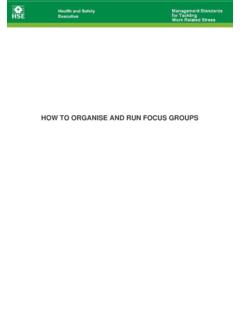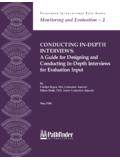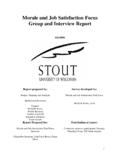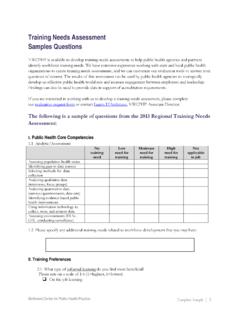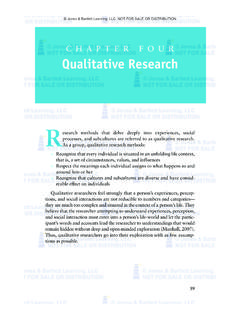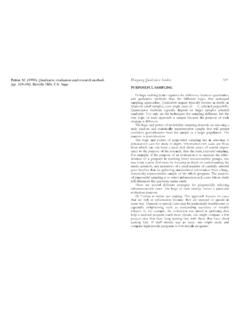Transcription of CRITERIA for JUDGING INTERVIEWS - Maine AD
1 CRITERIA for JUDGING INTERVIEWS . Present ideas and responses informally and orally that are appropriate to the setting and the questions asked Listen to the comments and inquiries of the interviewers and elaborate with interesting detail and vivid impressions while avoiding repetition. Establish and maintain rapport with members of the interview JUDGING team through voice, gestures and attitudinal posture. Use voice, vocabulary and language structures appropriate to informal oral communications. interview JUDGES' RESPONSIBILITIES. Conduct objective, consistent and uniform INTERVIEWS .
2 Create a positive atmosphere. Be personable, attentive and responsive to the student's comments. Avoid controversy in the interview . Do not argue, interrupt or display authority that will put the student on the defensive. Do not be confrontational. Be an active listener, listen not only to what is being said, but observe how it is said. Ask pre-determined open-ended questions. Follow-up questions may be asked. Refrain from asking question regarding race, religion, creed, ethnic groups, national origin or ancestry, political beliefs or affiliations or any question that can be so construed.
3 Help students relax and talk if you sense apprehension. Allow the student to complete his/her comments before moving to the next question or ending the interview . Keep on schedule!! 10 minutes per student: 1 minute preparation time + 7 minutes interview time + 2 minutes evaluation time After the student leaves the room, rate the student's interview performance. It is distracting to the student to be rated while he or she is speaking. UNITED STATES ACADEMIC DECATHLON. DESCRIPTORS for interview EVALUATION FORM Rating Scale Voice is the way a speaker controls volume, clarity, and distinctness of voice to gain greater audibility.
4 Voice should have a variety in the rate, volume, and pitch to engage interest, hold attention and convey self-assurance. Language Usage refers to the appropriate choice of words, proper use of grammar and correct enunciation. Language should promote clear understanding of thoughts and be appropriate for the occasion. Interpersonal Skills are measured by the candidate's ability to establish rapport with interviewers. The candidate's response should correspond to and interact with the interviewer's questions, and he/she should stimulate an involvement with the interviewers.
5 Non-Verbal Language refers to the manner in which the candidate uses gestures, facial expressions, and physical involvement for effective communication. Through the interview process, the individual reveals: Problem Solving Skills Organizational Skills Analytical Skills Promotional Skills When asking question of the candidate, keep these skills in mind. Help the candidate to develop experience in answering questions that reveal these skills. Manner is measured through he candidate's ability to speak with enthusiasm and assurance while showing interest in the interviewers and confidence in their reactions.
6 The candidate should be direct in his/her response. Appearance refers to the appropriate attire for the candidate. The candidate follows USAD dress standards. CONTENT. Listening Skills refers to the ability to analyze and interpret what is being asked. In order to answer skillfully and address the issue being considered, the candidate must listen carefully and attentively. The candidate's responses to the questions will give an indication of his/her level of attention and ability to identify, sort, and process the information being requested. Answering Skills refers to the ability to 1) address the issue being considered; 2) present information in a clear and concise manner; 3) organize information in a logical and sequential order; 4) adjust responses appropriately to a variety of audiences.
7 And 5) paces conversation to convey necessary information and achieve purpose. Order, logic, imagination, intelligence, and other personal qualities are reflected in the way answers are given. All information presented should be relevant to the question being asked. Responses refer to the quality of the answers given. The candidate should reflect on the questions to provide thoughtful and insightful responses. A well though-out answer engages the interviewers' attention and gives insight into the candidate's personal qualities, skills goals, and experiences.
8 Relevant examples and illustrations support the answers. The candidate should speak with certainty and conviction. Overall Effectiveness measured the 1) nature of information provided; 2) manner in which it was communicated; 3) overall impression it created, and 4) rapport established between the interviewer and candidate. Some of the questions to consider are: Did the candidate able to achieve a positive impression of this/her skill, experiences, and personal qualities? interview Rating CRITERIA Voice Volume Don't strain to hear Not aware of being loud Flexibility Vary Volume Vary tone Expressiveness Lively, animated and spirited Language Usage Grammar No slang or common phrases (like, really, you know, etc.
9 Inappropriate sentence structure Wide range of words and phrases Enunciation Proper pronouncement of words Words not slurred Understanding not strained Appropriateness Combined use of Grammar & Enunciation Interpersonal Skills Rapport Attentive, but relaxed Smiling Confident Interaction Acts in ways to engage others Involvement Eye contact with all judges Non-Verbal Language Movement Not fidgety or distracting Gesture Hand, arm and facial gestures to emphasize points Natural and appropriate vs. contrived or machanical Posture Erect but relaxed Purposeful and engaged Manner Assurance Confident, convincing and secure Enthusiasm Inspired, passion for ideas Directness Acts toward others to establish a relationship Establishes a relationship with judges Listening Skills Appropriateness of Responses Meaningful response to each question Attentiveness Eye contact with questioner Answering Skills Clear Don't strain to hear Not aware of being loud Flexibility Vary Volume Vary tone Expressiveness Lively.
10 Animated and spirited Language Usage Grammar No slang or common phrases (like, really, you know, etc.). Inappropriate sentence structure Wide range of words and phrases Enunciation Proper pronouncement of words Words not slurred Understanding not strained Appropriateness Combined use of Grammar & Enunciation Interpersonal Skills Rapport Attentive, but relaxed Smiling Confident Interaction Acts in ways to engage others Involvement Eye contact with all judges What is an Excellent performance? Student is enthusiastic, confident and an effective communicator from start to finish of interview .

